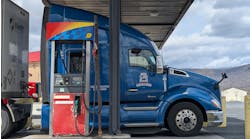Let's have a show of hands, please. Who would volunteer to wash a big sink full of dirty dishes in cold water? You know, just roll up your sleeves, plunge your arms elbow-deep into that chilly, greasy water and start scrubbing.
Not a chance, right? Besides really irritating the dishwasher, no amount of rubbing will do a very good job cleaning the dishes. So why do you suppose we still wash truck and even car windshields using cold water? Sure, we don't have to get elbow deep into the job, but it is certainly as annoying to peer through an oily windshield as it would be to sip from a greasy glass, and much more dangerous besides.
Soon, however, windshields may be getting the same hot, soapy scrub the glassware gets at home everyday, thanks to a company in Farmington Hills, MI, called Microheat Inc. (www.microheat.com). Next month the company plans to bring a new heated windshield washer fluid system to the trucking and automotive aftermarkets. The system, dubbed “HotShot,” is designed to rapidly heat washer fluid on demand without relying on engine heat, enabling drivers to quickly and effectively remove ice, snow, frost, road grime, oil and even insects. The hot fluid can also help to keep rubber wiper blades more pliable, allowing them to also work more effectively.
According to Microheat, HotShot produces hot washer fluid in about 30 sec. and sprays it on the windshield in intermittent spurts every six to ten sec., for a total automatic washing cycle time of two and a half minutes, or until the driver shuts it off. Thanks to the measured and controlled fluid flow, it won't crack cold windshields, either, the company says, even though it uses a burst of steam early in the cycle process to unblock any frozen nozzles in the system and free frozen wiper blades.
“The advantages [of HotShot] in cold weather are clear, but in warmer weather situations, driver vision can be severely hampered by the smear and glare caused by bugs, bird droppings and road grime, as well,” notes Emanuel Rosenzweig, vp-marketing for Microheat. “We've had dozens of trucking companies tell us that bugs are a huge problem for their drivers, sometimes causing them to pull off the road every hour just to clean the windshield. HotShot simply cleans better than cold fluid.”
Virginia-based owner-operator George McDonald agrees. He has been road testing a prototype HotShot system since August 2002 on his 2001 model Western Star truck. “I drive for Fed-Ex Custom Critical,” he says. “I've had a HotShot prototype on my truck since late summer and it works just great. I haul in the south a lot, so I haven't had the chance to test it in snow yet, but it really cleans the oil off the windshield on rainy days and it also works great cleaning off the bugs.”
Tom Lang, a spokesperson for the Microheat, says that the company plans to begin rollout of the new HotShot system at select Buick, Cadillac, Jeep, GMC Truck and Pontiac automobile dealerships in the 15 northern states and Canada this February. Truck fleets interested in the system are invited to contact Microheat directly. “We began thinking about the automotive market, but some of the greatest interest has been from commercial truck fleets,” Lang says.
This will come as no surprise, of course, to truck fleet owners and their driver who know only too well how important it is to structure the driving environment for safety and productivity. If the new HotShot system can truly deliver on its promises, the view down the road may be clearer than before thanks to a good idea that has been right there in plain sight all along.


